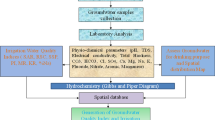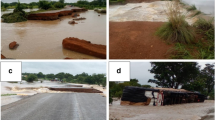Abstract
The identification of suitable groundwater potential zonation was prepared using remote sensing and GIS techniques. Drainage pattern map were generated from satellite images using Arc GIS software. This study area was demarcated the groundwater exploration sites and artificial recharges structure with help of groundwater potential zonation map. The assessment of groundwater potential zonation was generated by integrated data like Slope, Hydro-geomorphic, land use/land cover, digital elevation maps with the help of remote sensing, GIS techniques and field verification. The Geomorphology, Land use and Land cover maps were prepared from Linear Self Imagine Scanning Sensor (LISS-III) satellite images with 23.5 m resolution using Arc GIS 10.3 software. The different kinds of thematic maps were integrated for assessment of groundwater potential zonation in basaltic hard rock terrain. These thematic maps of classes assigned weight ages using overlay analysis method. The groundwater potential zonation map was prepared using thematic maps for groundwater development. These thematic maps were assign numerical values like 1–10 using Arc GIS software 10.3. The groundwater potential zone classes has been shown like poor, moderate, good and excellent, which can be utilized for new sites of groundwater exploration and artificial recharges structures. The artificial recharge map generated from groundwater potential zonation using remote sensing and GIS technology. The groundwater potential zonation and artificial recharge maps may be useful for soil and water conservation project, watershed development programs and groundwater resources management in basaltic rock area.










Similar content being viewed by others
References
Alley WM, Reilly TE, Franke OL (1999) Sustainability of groundwater resources. US Geological Survey Circ 1186
Baker ME, Wiley MJ, Carlson ML, Seelbach PW (2003) A GIS model of subsurface water potential for aquatic resource inventory, assessment, and environmental management. Environ Manag 32(6):706–719
Carver S (1991) Integrating multi-criteria evaluation with geographic information systems. Int J Geogr Inf Sci 5(3):321–339
Central Ground Water Board-India (2007) Manual on artificial recharge of groundwater. Ministry of Water Resource Board, Government of India, India
Cherkauer DS (2004) Quantifying ground water recharge at multiple scales using PRMS and GIS. Ground Water 42(1):97–110
Choudhary BS, Kumar M, Roy AK, Ruhal DS (1996) Application of remote sensing and Geographic Information Systems in ground water investigations in Sohna block, Gurgaon district, Haryana (India). Int Arch Photogr Remote Sens XXXI(B6):21
Colvin C, le Maitre D, Hughes S (2002) Assessing terrestrial groundwater dependent ecosystems in South Africa. WRC report no. 1090–2/2/03, Water Research Commission, Pretoria, South Africa
Corwin DL, Loague K (eds) (1996) Applications of GIS to the modeling of non-point source pollutants in the vadose zone. SSSA Special. Publ. no. 48. SSSA, Madison, WI
Hatton T, Evans R (1998) Dependence of ecosystems on groundwater and its significance to Australia. Occasional paper no. 12/98, land and water resources research and development corporation, CSIRO, Clayton, Australia
Javed A, Wani MH (2009) Delineation of groundwater potential zones in Kakund watershed, Eastern Rajasthan, using remote sensing and GIS techniques. J Geol Soc India 73:229–236
Khadri SFR, Pande C (2016) Ground water flow modeling for calibrating steady state using MODFLOW software: a case study of Mahesh River basin, India. Model Earth Syst Environ 2:1–17
Krishna Murthy BN, Renuka Prasad TJ (2014) Identification of groundwater potential zones using GIS technique in South Bangalore metropolitan region of Karnataka, India. Int J Geol Earth Environ Sci 4(3):9–22
Kumar CP (2013) Assessment and strategies for development potential of deeper confined aquifers in India. Asian Acad Res J Multidiscip 1(8):247–258
Kumar B, Kumar U (2011) Ground water recharge zonation mapping and modeling using geomatics techniques. Int J Environ Sci 1(7):1671
Majumder A, Sivaramakrishnan L (2014) Groundwater budgeting in alluvial Damodar fan delta: a study in semi-critical Pandua block of West Bengal, India. Int J Geol Earth Environ Sci 4(3):23–37
Minor TB, Russell CE, Mizell SA (2007) Development of GIS-based model for extrapolating mesoscale groundwater recharge estimates using integrated geospatial data sets. Hydrogeol J 15:183–195
Münch Z, Conrad J (2007) Remote sensing and GIS based determination of groundwater dependent ecosystems in the Western Cape, South Africa. Hydrogeol J 15:19–28
Murray J, O’Geen AT, McDaniel PA (2003) Development of a GIS database for ground-water recharge assessment of the Palouse Basin. Soil Sci 168(11):759–768
Neelakantan R, Yuvaraj S (2012) Evaluation of groundwater using geospatial data—a case study from Salem taluk, Tamil Nadu, India. Int J Remote Sens Geosci 1(2):7
Ranjana A, Rupali A, Sharmila P (2009) An assessment of groundwater quality of Chaksu town in Rajasthan, India. Curr World Environ 4(1):161–164
Rokade VM, Kundal P, Joshi AK (2004) Water resources development action plan for Sasti Watershed, Chadrapur district, Maharashtra using remote sensing and geographic information system. J Indian Soc Remote Sens 32(4):359–368
Sharma MP, Kujur A (2012) Application of remote sensing and GIS for groundwater recharge zone in and around Gola block, Ramgargh district, Jharkhand, India. Int J Sci Res Publ 2(2):1
Shiklomanov IA (1993) World fresh water resources. In: Gleick PH (ed) Water in crisis: a guide to the world’s fresh water resources. Oxford University Press, New York, Oxford, pp 13–24
Thomas A, Sharma PK, Sharma MK, Anil S (1999) Hydro-geomorphological mapping in assessing groundwater by using remote sensing data case study in Lehra Gage Block, Sangrur district, Punjab. J Indian Soc Remote Sens 27:31–42
Treidel H, Martin-Bordes JL, Jason J Gurdak (2012) Climate change effects on groundwater resources, a global synthesis of findings and recommendations, international association of hydro-geologists books series, no. 27, pp 1–37
Unesco IHP (2006) Groundwater resources assessment under the pressures of humanity and climate changes (GRAPHICS). United Nations Educational, Scientific and Cultural Organization (UNESCO), Paris, pp 1–19
Vijay Kumar and Rema Devi (2006) Krigging of groundwater levels—a case study. J Spat Hydrol 6(1):81–92
Acknowledgements
The authors are thankful to the Hon’ble Vice-Chancellor, Sant Gadge Baba Amravati University for providing the Necessary research facilities.
Author information
Authors and Affiliations
Corresponding author
Rights and permissions
About this article
Cite this article
Pande, C.B., Khadri, S.F.R., Moharir, K.N. et al. Assessment of groundwater potential zonation of Mahesh River basin Akola and Buldhana districts, Maharashtra, India using remote sensing and GIS techniques. Sustain. Water Resour. Manag. 4, 965–979 (2018). https://doi.org/10.1007/s40899-017-0193-5
Received:
Accepted:
Published:
Issue Date:
DOI: https://doi.org/10.1007/s40899-017-0193-5




